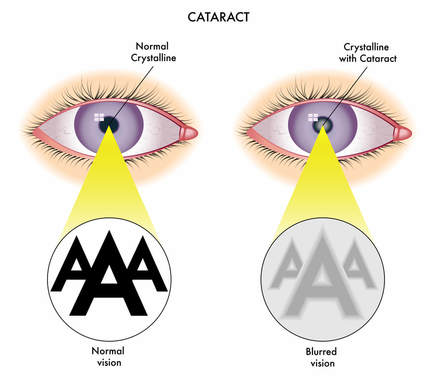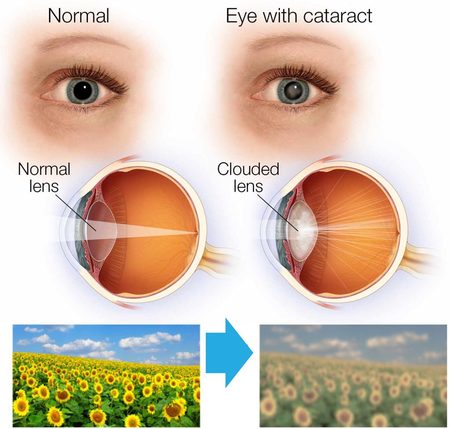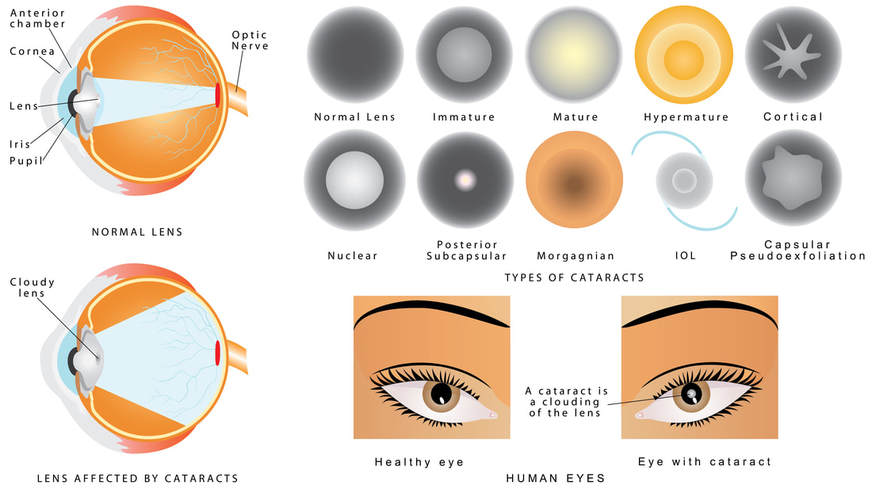
A cataract is a clouding of the lens in your eye which is normally transparent. The lens, located inside the eye, behind the iris and the pupil, focuses light onto the retina at the back of your eye, where it is converted to nerve signals that are passed to the brain, allowing you to see. When your lens becomes cloudy, the images projected onto your retina become blurry and unfocused and therefore the signal to the brain is also unclear. You can compare this to looking through a dirty or cloudy window. If the window is not clear, you can’t see well.
Cataracts don’t suddenly develop overnight. Cataracts are one of the leading causes of vision loss in people over 45. A condition that commonly develops as the eye ages, by the time we reach 80, more than half of us will have developed a cataract. Usually cataracts develop slowly over time so your vision gradually worsens. While the majority of cataracts are a result of the aging process, there are also congenital cataracts that are present at birth, secondary cataracts that result from eye surgery or diseases such as glaucoma or diabetes and traumatic cataracts that result at any age from an injury to the eye.
The symptoms people experience from cataracts may vary. Some individuals even report a temporary improvement in near vision when a cataract first develops, a phenomenon known as “second sight”.
During the evaluation of your eye health we will carefully examine your lens for signs of cataract formation. If a cataract is noticed and the clouding is causing visual disruption, the optometrist will refer you to a trusted and respected surgeon for surgery, which is the only known cure for cataracts. Our Eye Care Practice will be there for you providing pre and post cataract surgery care.
Cataracts don’t suddenly develop overnight. Cataracts are one of the leading causes of vision loss in people over 45. A condition that commonly develops as the eye ages, by the time we reach 80, more than half of us will have developed a cataract. Usually cataracts develop slowly over time so your vision gradually worsens. While the majority of cataracts are a result of the aging process, there are also congenital cataracts that are present at birth, secondary cataracts that result from eye surgery or diseases such as glaucoma or diabetes and traumatic cataracts that result at any age from an injury to the eye.
The symptoms people experience from cataracts may vary. Some individuals even report a temporary improvement in near vision when a cataract first develops, a phenomenon known as “second sight”.
During the evaluation of your eye health we will carefully examine your lens for signs of cataract formation. If a cataract is noticed and the clouding is causing visual disruption, the optometrist will refer you to a trusted and respected surgeon for surgery, which is the only known cure for cataracts. Our Eye Care Practice will be there for you providing pre and post cataract surgery care.

Here is a list of possible signs and symptoms of developing cataracts:
- Blurry or cloudy vision (that can’t be corrected with a change in eyeglass prescription)
- Glare from lamps, sunlight, oncoming traffic when driving at night or indoor lighting
- Colors appear dim and less vibrant
- Halos around lights
- Double vision
- Poor night vision
- Sudden improvement in near vision
If you experience any change in your vision, visit your eye doctor immediately.
While you may be able to live with mild or moderate cataracts, severe cataracts are treated with surgery. The procedure involves removing the clouded lens and replacing it with an intraocular lens (IOL) implant. Cataract surgery is a common procedure that has a very high success rate of restoring vision to patients. Modern cataract surgery is frequently done as an outpatient procedure. Patients will have greatly improved vision the next day, and will continue to improve over the next few weeks. Surgery is often done in one eye first, and surgery on the second eye, if needed, may be done 2 weeks later.
Learn more about the specifics of Cataracts on the links below:
- Causes of Cataracts Learn more about the risk factors associated with cataracts and what measures you can take to prevent or delay them.
- Treatment for Cataract & Cataract Surgery
Prescriptions, lens treatments and surgery are all options you can explore. - Intraocular Lenses (IOL)
If you need cataract surgery, you may have the option of getting new presbyopia-correcting IOLs that potentially can restore a full range of vision without eyeglasses.


